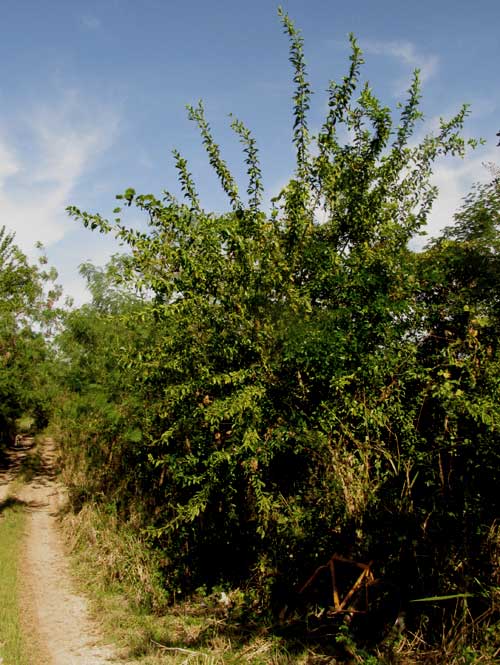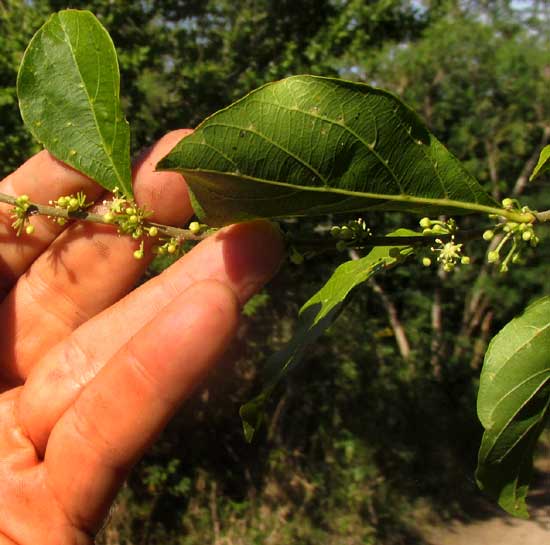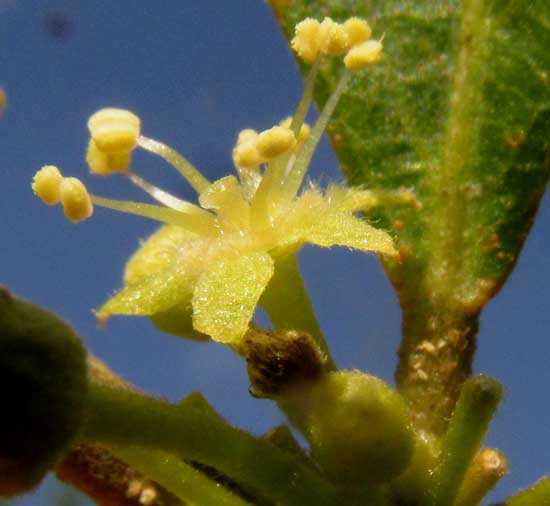Excerpts from Jim Conrad's
Naturalist Newsletter
from the December 10, 2017 Newsletter issued from Rancho Regenesis in the woods ±4kms west of Ek Balam Ruins; elevation ~40m (~130 ft), N20.876°, W88.170°; north-central Yucatán, MÉXICO
BRUSH-HOLLY FLOWERING
With the old one-speed bike I was straining slowly up a modest rise in the little kilometer-long road through the woods leading into the rancho. At the rise's summit I heard bees buzzing, and noticed a tree beside the road loaded with small flowers and their pollinators. Below, you can see my bike leaning against the very tree -- and notice how the weedy roadside is just beginning to dry up and turn brown here six weeks after the rainy season ended:

The small flowers grew in loose, few-flowered clusters along the tree's slender outer branches, as shown below:

Seeing the flowers, I realized that this was the same species as the knee-high bush, also heavily flowering, on the deep-pit rim beside the hut. I'd been trying for a couple of weeks to identify that plant, but so far couldn't. You can see it below:

So, already knowing that this was a hard one to identify, now was the time to began seriously "doing the botany." The first step was to take a nice close-up of a flower, shown below:

It looks like it has six or seven stamens, which is a curious number, and amid the stamens' filament bases there's a flat-topped stigma seeming too large for the puny ovary beneath it. The corolla-like part is so hairy and greenish that maybe the flower had no corolla, with the calyx doing the corolla's normal pollinator-attracting duty. A look beneath a flower showed a continuous connection between the pedicel and the corolla-like calyx -- therefore no corolla -- shown below:

Notice that this flower bears more stamens than the other one, so stamen number in this species isn't fixed, and that's a good fieldmark in itself.
Yet another important field mark is that the branches bore what's shown below:

That's a limb's spiny side-branch. The curious thing about it is that it's a spine with leaves growing from its side. It's half spine, half tree branch, a "spinescent branch."
After noting all these excellent field marks and walking around awhile scratching my chin, still I couldn't think of any plant family displaying such features. Finally, in desperation I pulled off a leaf and held it against the sky, and saw the tremendous ID feature shown below:

Botanists call those little bright dots between the veins "pellucid dots," and they appear in only a very few plant families. Normally they're supplied with aromatic oils or such. The most commonly encountered plant families producing trees with leaves with such dots are the Citrus and Myrtle Families. But citrus species produce flowers with corollas, so it isn't that, and Myrtle Family members usually have opposite leaves while these are alternate, plus the flowers are not unisexual as are these. In the end I had to go online and use the fine Plant-Family Identification Key freely available at http://www.colby.edu/info.tech/BI211/PlantFamilyID.html
That sent me to a plant family little known to most Northern botanists, the Flacourtia Family, the Flacourtiaceae. But with genetic sequencing, most experts have decided that the Flacourtia Family consists of genera and species that better belong to other families, so nowadays the Flacourtia Family usually is considered as dismantled. Amazingly, our roadside tree now belongs to the Willow Family, the Salicaceae, though most of us might find it hard to see much willowy about it.
Knowing the family, it was easy to figure out that our tree is XYLOSMA FLEXUOSA, widely distributed in a variety of environments from the southernmost tip of Texas through Mexico and the West Indies, through Central America to northern South America. In English it's called the Brush-holly, though it's not much related to the hollies. The online Flora of North America says that often it occurs in moist soils, as in palm groves, but here I find it in thin, dry soil atop limestone outcrops.
I just love having to work for an identification like this. And meeting a whole new kind of tree -- though I've passed it a hundred times during the last year -- is especially a pleasure.